Google’s Favorites: The Best Content for Private Practice SEO
 Almost like an actual person, Google has its own preferences and quirks. It rewards certain kinds of content and shuns others when it comes to deciding which websites show up on its first page of search results. And since Google gets to decide the rules for how it ranks its own search results, we all have to play by those rules if we want to rank well when writing content for private practice SEO.
Almost like an actual person, Google has its own preferences and quirks. It rewards certain kinds of content and shuns others when it comes to deciding which websites show up on its first page of search results. And since Google gets to decide the rules for how it ranks its own search results, we all have to play by those rules if we want to rank well when writing content for private practice SEO.
You may already know that one of the most powerful tools in your battle for SEO greatness is quality content. However, not all kinds of content will charm Google’s search engine algorithms. Among many other things, Google craves thoughtful, high-quality content on subjects that people actually want to read.
Worried your website might be lacking in other ways? Try our FREE Website Grader to check for yourself!
There might’ve been a day when you could easily raise your site’s search ranking by posting pages of long, meaningless blocks of keywords, or by copy-and-pasting relevant content written for a different website. Nowadays, though, Google is much too smart to be fooled by tricks like those. If you want to rank the best with Google, you’re actually going to put in the time and effort to post original, relevant content.
Google will be looking at not only what you’re posting to your website, but how the content was made – Did you use keywords throughout? How many different pages did you use? What did you put in your “title tags”?
If you’re starting to feel overwhelmed, don’t worry! As always, we’re here to walk you through all your essential information for getting started with content for private practice SEO, without any of the unnecessary fat.
The 6 Best Kinds of Content for Private Practice SEO
 Before we talk about reasons why certain kinds of content rank so highly, let’s look at some of Google’s favorite types of content that work well for practice websites. We want to focus on kinds of content that are both effective and achievable for a private practice website.
Before we talk about reasons why certain kinds of content rank so highly, let’s look at some of Google’s favorite types of content that work well for practice websites. We want to focus on kinds of content that are both effective and achievable for a private practice website.
1. A regularly updated blog
This isn’t simply a “blog” page where you put up a bunch of useful information and then walked away. It’s not enough anymore to simply be a static encyclopedia of information – your website has to grow and change over time, adding valuable content regularly.
You don’t need to update your blog daily for it to be considered “regularly.” In fact, we recommend adding content to your practice blog every week or two for the best results with Google and the least strain on you.
A great example of a regularly updated blog is the one you’re reading right now – Brighter Vision’s blog! We update our content at least once a week in hopes that when you visit us, there’s always something new to explore.

Brighter Vision’s blog page
2. Category landing pages
When you have several different pieces of content that fall within the same category on your website (for example, multiple therapists in your group practice, multiple services you offer, etc.), it’s a great idea to create a category landing page. This is a page where your visitors can go to get a quick overview of each of their options, all at once, before making a decision where they want to go to learn more by choosing from available links.
A particularly great use for category landing pages on practice websites is to help explain your different services or specialties. Check out this example of a Services page from Thrive Counseling Services.
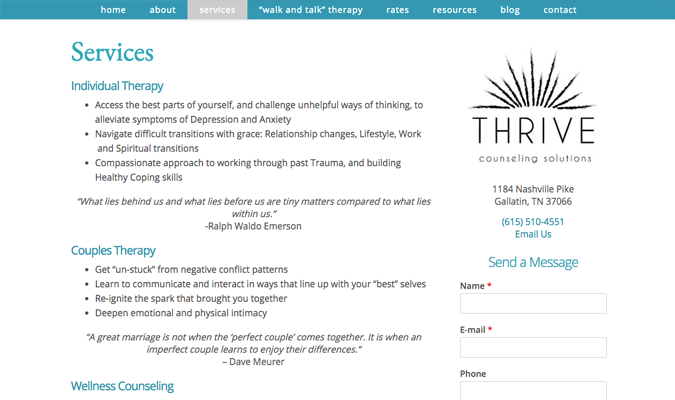
Services landing page for Thrive Counseling Services
Thrive has done a great job of giving a little taste of each of their services by supplying a short description. And when their website visitor wants to learn more about a particular specialty, they simply click on the title to be whisked away to a separate page which goes far more in depth on the service.
3. Shorter, static content
Something both Google and your website visitors will love are succinct & timeless pieces of content that can serve as a quick reference point or explanation for your potential clients. On practice websites, this is a great option for some of your specialties or services that don’t require as much explanation as others, or for information about your practice that is important enough to have it’s own page, even if it’s not article-length.
To show you the kind of length we’re talking about, let’s look at this example from Mansfield Counseling.
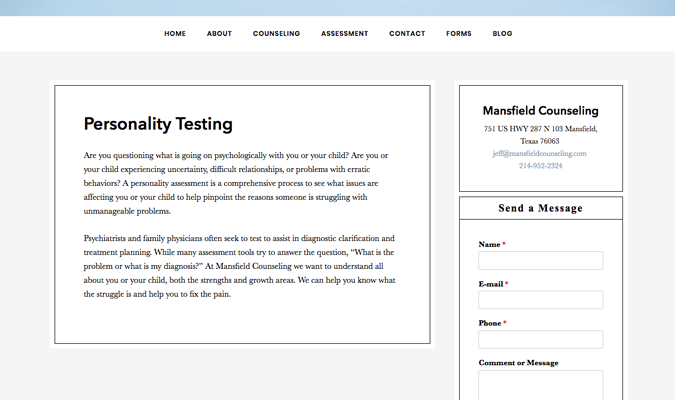
Mansfield Counseling’s page on Personality Testing
This pithy page can be located from their main navigation menu, but it’s also connected to a category landing page about their Testing & Assessment services. It’s clear and to the point, but with at least one full paragraph of text, it’s substantial enough to hold up a web page on its own.
4. Longer, information-packed articles
You may think that lengthy, in-depth articles are something that modern Internet surfers have left in the past with our short attention spans. So you may be surprised to learn that well-researched and accurate articles that go into their topic in-depth actually rank well with Google when it comes to content for private practice SEO.
Maybe we can chalk it up to our renewed cultural hunger for quality research and reporting of late. Either way, the fact remains it’s good news that if you put in the time and effort to create a weighty and accurate piece of content, it will be rewarded.
Take a look at the size of this piece from Focus Therapy on helping athletes return mentally strong to their sport after a failure or mistake.
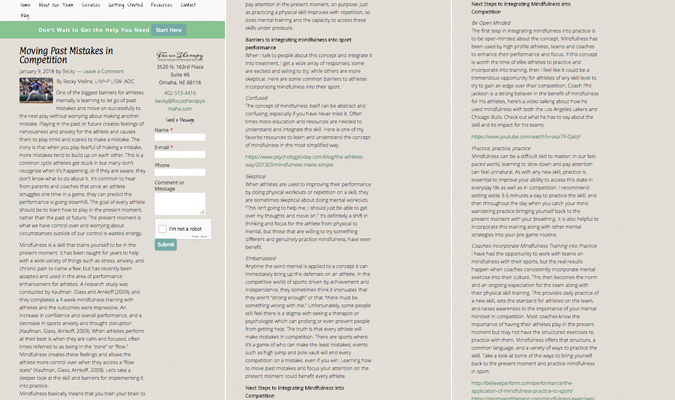
Focus Therapy’s article on athletes’ mental recovery
You can see at a glance that this isn’t your typical blog post length. This is an article that isn’t afraid to really dig its fingers into the subject at hand. That’s the key to succeeding with these longer articles – it’s not simply about writing more length, it’s specifically about writing more in depth. Make sure you’re exploring your chosen topic in a unique and/or critical way.
5. Detailed listicles
In case you haven’t heard it before, yes – that’s a real word! “Listicle” is a word that emerged in the early 21st century to describe an article that consists of a list, primarily or in part. In other words, every Buzzfeed article that starts with “16 Reasons to…” or “20 Photos that…” is a listicle.
So how can you effectively use a listicle on your practice website?
Sounds like it’s time for our content example, this time from Change Agent & Associates.
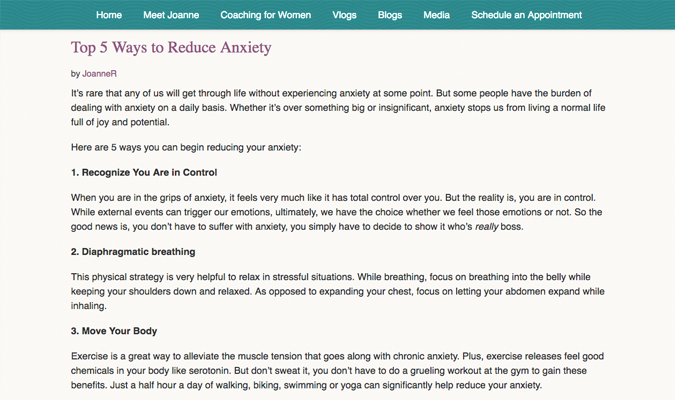
Change Agent’s article on Top 5 Ways to Reduce Anxiety
Looking at this listicle in person also reveals another great benefit of this kind of article. Even though each individual point isn’t very long, they’re able to come together cohesively to form a fuller article. It can be a huge time saver for you as the content creator when you want to put out a full-sized article, but you don’t have the time or experience to go into each point in a great deal of detail. Not to mention, listicles are such a trendy article format right now that you’re bound to enjoy an increased view count!
6. Video posts
I know that making your own online videos might seem daunting, but once you get into it you’re likely to discover it’s even quicker than writing a blog post! And not only that – videos will reward your SEO when your potential clients flock to them.
We actually wrote a blog post on how to start making videos for your practice website if you’re looking for a bit more guidance.
Here’s a quick example of a video post from Wishall Wellness on the subject of naturally correct posture.
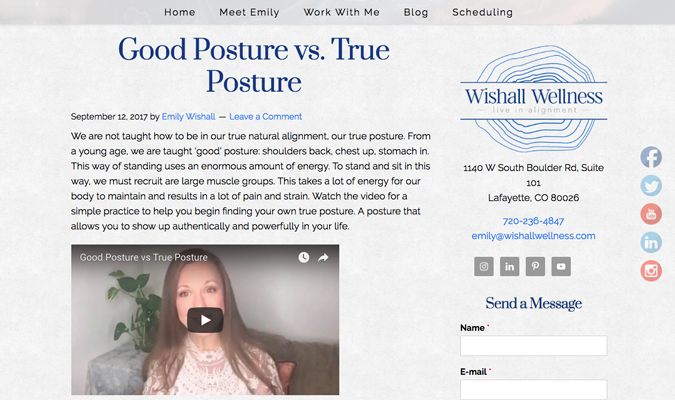
Video on posture by Wishall Wellness
The video has its own blog post where it can live, sandwiched by small paragraphs explaining a little more about the video and including a call to action (CTA) to the website visitor. Simple and short, yes, but it draws traffic and boosts SEO partly because of its short, convenient length.
How to Make Google Like Your Content
1. Use keywords

It wouldn’t be an article about SEO if we didn’t talk about keywords! As a quick refresher or for those who don’t know, “keywords” (also called “keyword phrases” sometimes) are popular words or short phrases used in search engine queries. Keywords are different depending on what you’re seeking as a search engine user, and what kind of page you’re trying to get those search engine users to choose.
For example, let’s imagine that your practice website has a specialties page for addiction (it could be one of those 3. Shorter, static pages we just talked about). Some great keywords to go with that page could be, “drug addiction,” “alcohol use,” “pornography addiction,” “sex addiction,” “addiction recovery counseling in [your city],” “addiction support group in [your city],” etc.
Notice that I didn’t list the singular keyword “addiction.” Super broad keywords like “addiction” that don’t have any added specificity to them will not serve you well. That’s because you’re competing with other websites to show up higher in the search rankings for particular keywords, so the broader the topic of the keyword, the more vicious the competition can get. You’ll see much better results from narrowing down your keywords with descriptors like we have with our list above.
So where do you use keywords to boost your SEO?
• Sprinkle them in organically throughout any text or descriptions, integrating them naturally instead of awkwardly squeezing them into phrases where they don’t belong. (For example: “It’s difficult when loved ones don’t understand your post traumatic stress disorder symptoms.”) It’s a good goal to use a few keywords per paragraph. However, you should know that Google looks particularly at the first 100 words of the text on your page. So it’s a good idea to increase the diversity and frequency of your keywords in that area.
• Feature them prominently in your titles & subtitles. Google pays extra attention to how you choose to label your page content, and titles are a big part of this. Use keywords in your official title/heading tags for a real SEO punch-up!
• The first 59 characters of the URL are super important since certain online platforms may not look at characters in your URL after that point. This is an essential area to fit in a solid keyword or keyword phase to help define the purpose of that page to Google.
When you’re using keywords, always remember to use a variety! Even if your favorite keyword or keyword phrase is absolutely perfect, you don’t want to end up repeating it all over your website. Repeat keywords sparingly and mix it up, building a small list of closely related keywords instead of using the same one over and over.
2. Don’t clump your content

One of the absolute best ways to make your website content work harder for your SEO is to avoid clumping it all together in the same space. While it may satisfy your craving for organization to sort all your site content into just a few pages, you’ll actually benefit much more if you give each topic (and sometimes sub-topic) it’s own page and space to live.
A big reason for this is the extreme character limits on SEO tags for your web pages. In other words, if you cram too much information onto a single page some of it may get overlooked when Google is evaluating your website’s SEO. It’s important that you give separate topics their own page to exist on your site so that Google can accurately see how diverse your information is and how intensive the information is for each individual topic – instead of having to guess based on a large grouping of content that gets hard for Google to parse.
An excellent way to integrate this idea into your practice website is to utilize the content forms we talked about earlier – 2. Category landing pages and 3. Shorter, static pages. By using category landing pages for your main hubs of information – like your list of specialties or staff – and then branching out the individual options into separate shorter, static pages, you’ll end up looking far more organized AND more knowledgeable to Google.
3. Regularly update

One of Google’s favorite things to see in a website is regularly updated content. That means you can’t just upload a bunch of informative content when you first make your site, and then assume you can just sit on your pile of info and reap benefits forever. Google wants to see that your site content is constantly moving forward and being updated.
Obviously blog posting is a wonderful and easy path to accomplishing this, but it isn’t the only way! Consider posting daily inspirational quotations, or maybe even a blog post recommendation of the week. We’ve even seen practice websites use a revolving site tagline as regularly updated content on their site.
4. Make it shareable

It’s no surprise to anyone not waking up from a 20-year coma that shareability is one of the biggest factors to online success for content nowadays, but what makes something “shareable”?
Shareable content’s value is immediately evident. People will only share something that makes its value obvious right away, typically by using titles and any preview images to communicate exactly why you would want to learn more, watch further, etc. If an explanation needs to be included whenever someone wants to share your content with a friend, you’ve done something wrong. Fun wording in titles and previews can be ear catching, but don’t forget to squeeze some cold-hard facts into your title and any descriptive text so people know what they’re getting.
When the value of your content is immediately clear, the only effort someone has to go through to share your content with a friend is sending a link. And that convenience is powerful.
Shareable content also loads quickly on any device. More and more with each passing year, we can never be sure what device someone will be using to view a website. Data-heavy content like full-size photo albums or multiple videos on one page may load fine on your desktop computer at home, but someone trying to view that page of your practice site on the bus during their commute is going to have to sit through a long loading screen. Potential client may click away before you even had the chance to pique their interest.
It’s important to note that one of the first factors that Google takes into account when it comes to ranking your site is time, so even with the best content in the world it may take a little patience before your brand new website is reaping big rewards from your increased SEO.
Yet even the oldest websites won’t rank well if their content is subpar. At the end of the day, the quality of your content is a huge part of why your website ranks the way it does. Follow these steps to improve your
Could your practice be ranking better in search results? Let Brighter Vision build you a beautiful, SEO-boosted website, and watch your private practice grow to new heights!
Reach out to our customer happiness team by filling out the form below.



Lynn nice article! How do you find keywords without having to pay for them?
Hi Tony, I’m glad you liked the article! Once you get the hang of keywords you can brainstorm them on your own, but there are a lot of excellent free resources online that can give you great, long lists of related keywords to get you started. For example, Keyword Tool will give you a list of dozens of related keywords for free. And if you ever want to check on how popular a certain keyword or keyword phrase is, Google Trends is a free and wonderful resource for any fellow data nerds. 🙂
Thanks Lynn, could you please give me an example let’s saying using the keywords “Mental Health Talks for Churches.” Thanks in advance.
This article was helpful and informative. However, it seems to contradict Brighter visions blog subscription service doesn’t it? Blogs your staff writes violates the original content rule doesn’t it?
Thank you for leaving a comment, Nathan! 🙂 This is an excellent question, I’m happy to dive in a bit.
If you’d like the “long version” of this answer, please feel free to email our expert support team ([email protected]), but I’ll try to make a long story short: Yes, if you want the best SEO possible for your practice site, you’ll want to use original content wherever possible. However, doing that all the time – for every single blog post and page – isn’t always practical because of time & other resources, even for big brands and websites. The good news is that Google does not penalize repeating or similar content like the Growth Platform library of professionally written blog posts. Growth Platform users still get the massive SEO benefits of updating their website’s content, and posting content to their site that is relevant to their practice, search engine optimized, and keyword-filled. Making that content all-original does give you some tasty SEO “sprinkles on top,” so to speak, which is why it’s included in our recommendations for the maximum “best” SEO for your private practice website. 🙂